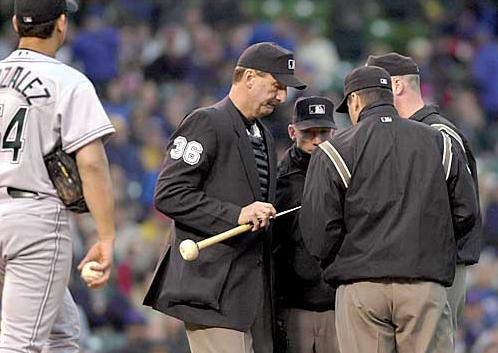 |
| Umps checking out a corked bat. |
Growth hormone and physical performance
Birzniece et al 2011. Trends Endocrin Metab 22:171-178
This review covers a great deal of territory we have covered before. The drug, hGH, is widely abused through sports due to a poor ability to detect this type of doping and as a result of uncertain effects. The science literature has found scant evidence of hGH helping improve athletic performance. It has been found not to affect muscle strength, power, or aerobic capacity. Ho's groups' own studies have observed that it does improve anaerobic capacity. However, his findings have not been duplicated (nor has anyone published anything attempting to duplicating them). This means there is a slim bit of hope that hGH might improve a baseball player's ability to sprint, but not much else. That improvement, if true, is likely to be largely ineffective. The effects they found could have ramifications in events for short distances in track and field, but would wind up being the difference of a half or a full step. As far as I am aware, there has not been a massive increase in infield singles in professional baseball.
Corked bats, juiced balls, and humidors: the physics of cheating in baseball.
Nathan et al. 2011. Am Ass. Phys. Teach. (pdf)
In this study, the researchers looked at how corking a bat affected how a ball traveled off a bat, compared how lively balls were between now and the 1970s, and to what degree a humidor affects the distance traveled by a baseball. They found that corked bats would result in a shorter distance traveled, but a faster bat speed. This reiterates what has been repeatedly found: corked bats help slap hitters, not home run hitters. With balls from different eras, they found essentially no difference between them. Studies focused on this question have run back and forth, it would be interesting to see a better done study on this with full characterizations of unused game balls over several eras. Finally, the ylooked into how humidors affect distance traveled. Unsurprisingly, they found that the use of a humidor can account for the decrease in home runs at Coors Field.
I think the first and third questions have been largely answered. I am not entirely pleased with how they answered the second question. I would have preferred a greater range of baseballs and a greater degree of characterization. Additionally, I would also like to see more information about how game used balls differ from unused ones.
Balance ability and athletic performance.
Hrysomallis 2011. Sports Med 41:221-232.
Previous studies have shown that in general, athletes of specific sports are less injury prone if they display better balance. In this study, they reviewed past articles on how balance could affect several skills in several sports. With respect to baseball, they reviewed a Marsh et al 2004 study. That study found that using several different balance metrics did not correlate to distance missed from a glove target when pitching. It is not an ideal study, but it certainly is an interesting question to pose an interesting way of answering it. Balance certainly predicts success with archers and sharpshooters. It might be good to expand this study beyond pitching accuracy to other aspects of the game (i.e. defense, contact rate) or including mechanics into the balance equation for pitching accuracy.
No comments:
Post a Comment